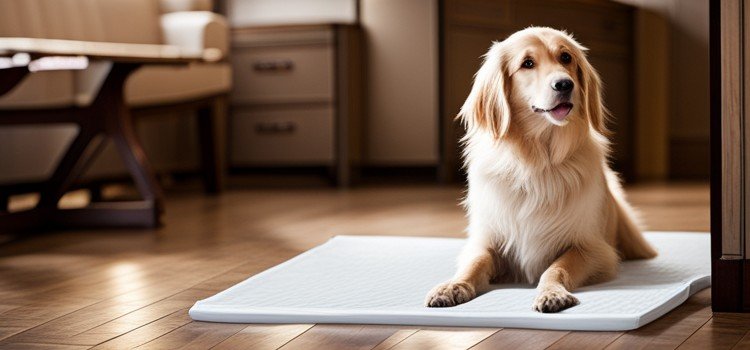As an Amazon Associate committed to the mission of improving the lives of our readers, Live-Clear.com receives a small commission from eligible purchases made through our affiliate links. This revenue enables us to keep producing insightful articles and other material.
Introduction
Teaching the use of pee pads to mature dogs presents a practical method to address diverse circumstances, such as aged dogs experiencing limited mobility, inclement weather conditions, or residing in apartments lacking convenient outdoor accessibility.
Although training an older canine companion to use pee pads may require more patience and persistence than training a puppy, it is possible to achieve success by employing the appropriate approach.

Choose the Right Pee Pads
Selecting the appropriate pee pads is the first step to successful training. Look for absorbent, leak-proof pads, and large enough to accommodate your dog’s size. You should experiment with a few different brands to find the one that best suits your dog’s needs.
Find the Right Location
Pick a location where you’ll put the pee pad. Your older dog should have no trouble getting there, especially if it has mobility issues. This area should ideally be distinct from where they are eating and sleeping to avoid confusion.
Establish a Routine
Consistency is vital when training any dog. Set a regular schedule for potty breaks, similar to what you would do for a younger pup. Take your dog to the selected pee pad area first thing in the morning, after meals, before bedtime, and any other times they’ll likely need a bathroom break.
Use Positive Reinforcement
An effective training method for older dogs is positive reinforcement. Give your senior dog lots of praise, treats, and affection whenever they use the pee pad correctly. They will be inspired to repeat the behavior because of the favorable association.

Closely Monitor and Supervise
Keep a close eye on your dog, especially in the beginning stages of training. Watch for signs they need to relieve themselves, such as sniffing, circling, or pacing. If you notice these signs, quickly guide them to the pee pad area.
Address Accidents Calmly
Accidents are a natural part of the training process. If you catch your dog in the act of using the wrong spot, calmly interrupt them and guide them to the pee pad. Avoid scolding or showing frustration, as this could create anxiety around using the pee pad.
Clean Accidents Thoroughly
Accidents can leave behind odors that might encourage your dog to use the same spot again. Clean any accidents promptly and thoroughly using an invented enzymatic cleaner to eliminate pet odors. This will help prevent repeat incidents.
Gradually Decrease the Number of Pads
As your older dog becomes more accustomed to using the pee pad, you can gradually reduce the number of pads in your home. Start by removing pads from areas your dog rarely visits and gradually limit them to just one or two designated spots.

Conclusion
It takes time, persistence, and rewards to teach an older dog to use pee pads. You can successfully teach your older canine companion this new skill by choosing suitable pads, establishing a routine, closely supervising your dog, addressing accidents calmly, and gradually reducing the number of pads.
Every dog is unique, so be prepared to adapt your training approach to suit your dog’s needs and preferences.
Amazon and the Amazon logo are trademarks of Amazon.com, Inc, or its affiliates.



